I’ve always really loved management games, so you can imagine how stoked I am that the genre has been doing relatively well the past few years. Tons, and tons of releases all the way from big studios down to little indie ones, means there’s always a management game out there for you to play. Of course, you don’t want to trudge through all that to find the best ones, which is why I did it for you! (I’m such a nice guy).
One little preface I want to put here before getting started though, is that the term ‘management’ is a little bit vague. There aren’t many pure management games, as the management genre itself tends to come hand-in-hand with the simulation genre. Either way, I’ll do my best to include games that are as close to management as possible, while still being super fun and engaging to play.
#1 Two Point Hospital
If you’ve ever played games in the mid-2000s, then you’re probably familiar with Hospital Tycoon, a hilarious take on running a not-so-real-life hospital. Well, Two Point Hospital, made by some of the original developers of Hospital Tycoon, is the spiritual successor. In fact, it’s so good it’s even included on our list of top 10 tycoon games.
Taking place in the aforementioned Two Point area, the game brings in some more modern design mechanics that you might be familiar with. In this case, the ‘campaign’ is spread out over several hospitals in the local area, with each unlocking as you gain more stars for each hospital (up to three each).
Similarly, treatment rooms, diagnosis and all the related fun medical stuff is also unlocked as your number of stars increase, and you’ll see yourself revisiting your old hospitals to bring add all the new stuff you’ve unlocked.
The management aspect of the game is absolutely top notch, and while it’s not really simmy in the sense of how realistic it is, it’s both fun and challenging. A lot of the game’s mechanic revolves around trying to keep up with the increasingly large number of patients that come into the hospital. Of course, it’s never as easy as just hiring more nurses or doctors, as each has traits which make them more effective on different things.
For example, some nurses are really great with pharmaceuticals, and so decrease the treatment time for anything that requires pills. Similarly, you might have a doctor who is great at diagnostics, the first step in getting patients treated and arguably one of the most important focuses in terms of management.
Thankfully though, you do have the ability to train doctors with new abilities in a teaching room, although then you run into the problem of taking those doctors out of rotation, so you have to hire more. It’s almost an infinite feedback loop of trying to get things to run properly.

All of that is wrapped into some of the funniest medical maladies that you’ll find since the old game. Maybe you’ll have somebody with a lightbulb in place of their head, or a pan stuck on it. Otherwise will have an immutable belief that they’re actually clowns. Probably my favorite though is the ones who believe that they’re Freddie Mercury from Queen, and boy are they a joy to watch.
Treatment is equally hilarious, with an increasingly complex set of machinery for curing, from the simple pan remover to the Debugger for those who suffer from 8-bit disease. Of course, the problem then becomes how do you fit these larger and larger machines in ostensibly small hospitals, and that’s where the space management aspect comes in.
While you absolutely can expand hospitals, it costs quite a bit and there’s still a finite amount of upgrading you can do, so sometimes you have to really pick and choose what you’re going to treat. Two Point Hospital is a great modern retelling of the classic, that is as hilarious as the old one, and even better in terms of the management mechanics.
#2 Oxygen Not Included
If you’ve played Don’t Starve and loved it, then you’ll get along really well with their next release: Oxygen Not Included. As you might expect from the title (and their previous game), there’s a heavy amount of survival in ONI, but instead of a top-down adventure, you’re dealing with a side-facing fight for survival.
Teleported into an asteroid somewhere in space, you are put in charge of Dupes (short for Duplicates), not only telling them what to do, but also trying to keep them alive. Of course, it’s not so much like The Sims where you have direct control of them, but instead it’s more like Rimworld, where you set general tasks and let them worry about getting to it.
Where the real danger comes from though, is the environment, I don’t necessarily mean the mobs. Being inside an asteroid, oxygen is in short supply, and not only that, but there’s a variety of different gases that are more than happy to kill you. Thankfully, a lot of them are locked in their own chambers, along with the oxygen, so a large part of the game revolves around planning your base building around not accidentally breaking into these chambers.
Of course, it’s never that simple, and you do have to worry about feeding your Dupes, as well as dealing with their waste. Much like gases, liquids can also be toxic, and in what is probably a slightly too real representation, you’ll end up having to excavate a literal shit hole where the Dupes can dump their waste.
If you don’t, you’ll end up getting your Dupes sick, and you really don’t want to do that when you’re just barely hanging on by the skin of your teeth.
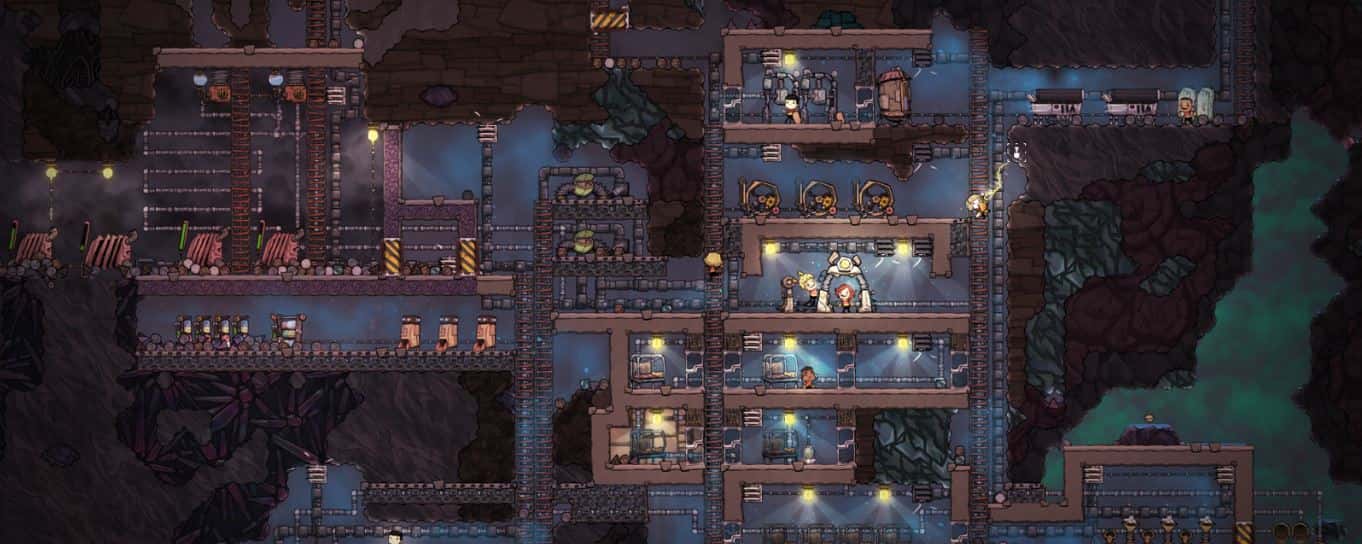
The end-goal of the game is rather anomalous, in that you have to dig your way up to build a rocket ship to escape. Yeah, the story isn’t anything fancy, and while there are little tid-bits of lore here and there, it pretty much becomes irrelevant after a while. Similarly, while at the start you might care about your Dupes, give it some time and you’ll only really care about their stat trees, more than anything else.
That’s not to say that the game isn’t incredibly fun and stupidly challenging, maybe even too challenging. ONI has a ton of replayability to it, mostly because it takes a while to get the hang of things, just like some of the best management games do. This can get frustrating at times though, especially if you don’t read the tooltips thoroughly and accidentally manage to release the plague.
All in all though, Oxygen Not Included has the right mix of fun management and punishing survival. You’ll probably end up banging your head against the wall a lot until you get used to the variety of complex systems, although that’s certainly one of the fun parts of these types of games.
#3 Factorio
Another game that’s taken a spot for our best simulation games, Factorio is all about trying to figure out an increasingly complex array of production facilities.
When you first start out, you find yourself in a barren landscape with really not much going for you. You have a gun, a flashlight and the ability to build mines for extracting some basic ores, as well as smelters and things of that nature. While the main goal here is to try and build a rocketship to escape, it starts becoming more and more complicated.
The planet also has some indigenous life that aren’t super friendly to you, mostly because you’re creating a bunch of noise and pollution on their planet. As such, defending yourself and your base becomes a big part of the gameplay. It’s never that simple though, because ammo and guns need to be made, so it’s not just a matter of loading up and going out on a killing spree.
This is where Factorio really shines though, as you have a near limitless variety of things you can build and research. For example, you may need circuit boards for your automated turrets, but to get those, you need to build them from plastics and other ores. To get those plastics you need to mine and then refine oil, same goes for the ores. You’re constantly expanding try and get more and more done, while maintaining a handle on everything.
Of course, the game doesn’t just leave you to run around trying to constantly put out metaphorical fires. This is where the automation system jumps in, with it’s conveyor belts, splitters and pick up/drop off arms. It’s actually a beautiful and intricate dance of sets of moving parts working together to serve a specific goal, such as building a circuit board, or ammo.
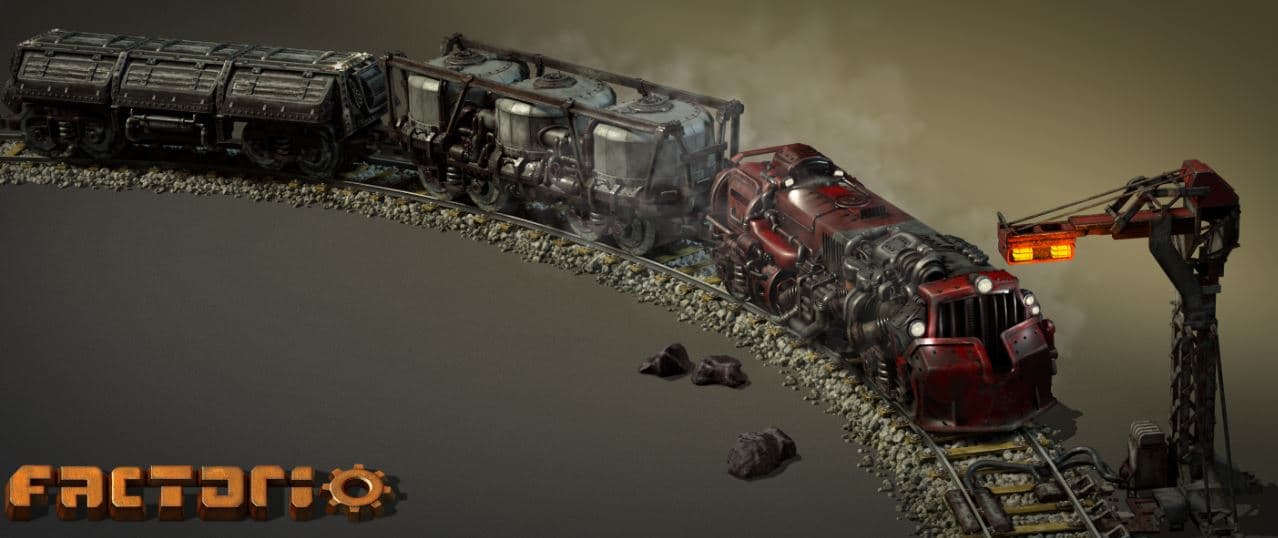
There’s also a massive map for you to explore and expand to, or I should say, that you have to expand to. Very rarely do you start with all the minerals nearby for you to harvest, and so you’re forced to go out into the wild to find things such as oil, uranium and even water for your steam engines.
It’s a dangerous proposition though, because the further out you get from your starting position, the more aggressive the native population is, and they come in larger and larger numbers.
Overall, Factorio is an awesome game that is just as much a puzzle as it is a management game. A lot of the time you’re trying to figure out how to most efficiently build and automate your production in such a way that you aren’t constantly loading and unloading things. It can get a little bit tedious as you get closer to your end goal, but there’s no better feeling than seeing a massive, sprawling factory complex that spans the whole map.
#4 Farming Simulator 19
I often go on about how great Farming Simulator is as a zen game to just mindlessly relax on playing . . . probably something I should stop doing when I go out on a date. In all seriousness though, Farming Simulator 19 is not just about planting and harvesting crops, and there’s actually quite a bit of management behind the whole thing, especially in the last few iterations of the game.
Let’s take forestry for example, something that was added a couple of iterations ago and has been made even better in this version. It follows the path of growth from the very little, tiny cute sapling that you plant, all the way to when it grows into a full blown tree and you cut it down . . . moving on. After that, you can turn them into wood chips or sell the logs by transporting them on the train.
Of course, it’s never that simple, and there are a variety of trees for you to plant and harvest, as well as a ton of different forestry trucks and tools for you to choose from.
In a similar fashion, you can raise animals and sell their produce, and that becomes a bit more complicated. For starters, feeding a bunch of animals isn’t really easy, and if you’ve ever lived on a farm, you’ll know how much food you can go through, so the first thing you need to do is grow their food. Then, you have to prepare their food in silage tanks, which itself can take quite a bit of time and effort, let alone having to feed them.
Thankfully, all that work rewards you with a variety of different products, like milk and manure, the latter of which you can use to fertilize your fields, rather than having to buy the inferior fertilizer from the shop. Similarly, we can’t forget the actual agricultural part of the game, where you can plant a variety of different crops to harvest, each selling for different rates at different times.
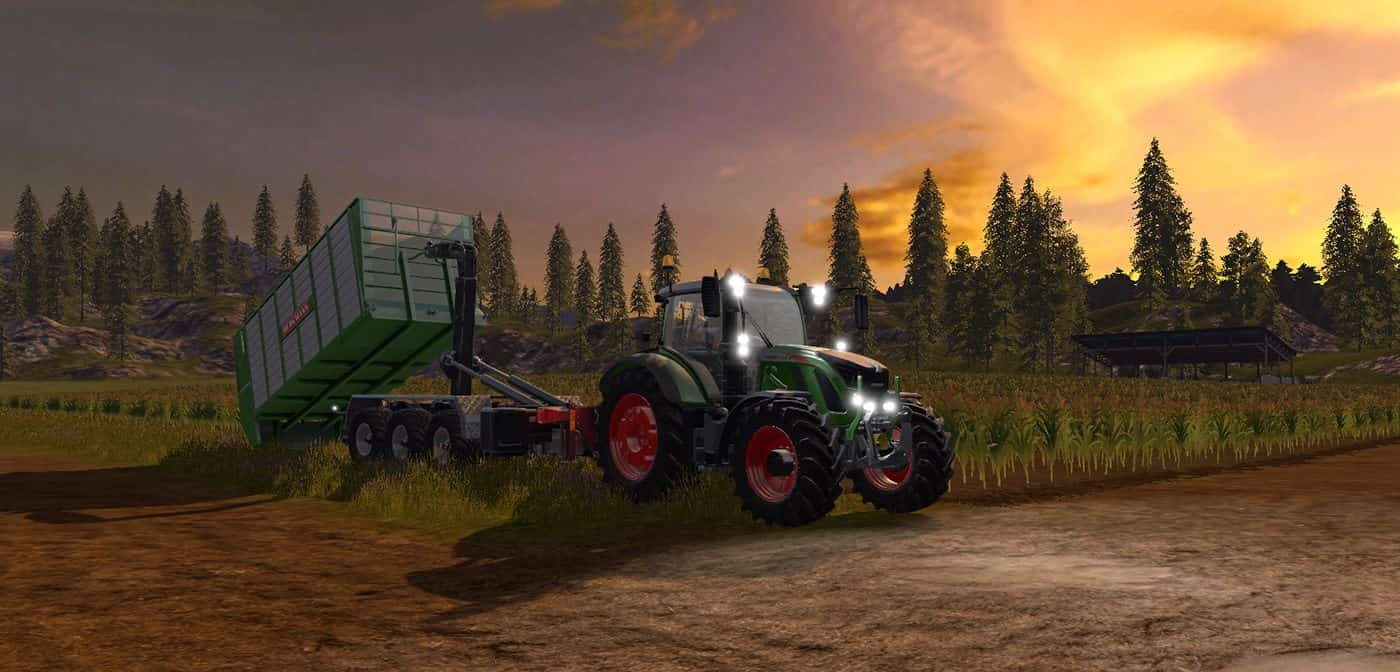
There’s also the question of some crops requiring special equipment, which adds another level of complexity to your considerations. Should you go for a medium-yield crop that sells ok, or a low-yield crop that sells excellently? Would you prefer to put in a ton of time and effort per crop, or just try and enjoy yourself and play the game more leisurely?
One thing that really makes the game stand out though, is the massive amount of modding and the community behind it. There’s literally hundreds of equipment from you to choose from, such as bigger trailer than what the base game offers, or just different skins for the trucks that are already in-game.
Ultimately, Farming Simulator is about trying to constantly manage the variety of needs in the three different areas of the game with your own ambitions and goals. While it’s true you can just sit back and relax doing the absolute minimum, you’re equally as well served by going out and trying to figure out and maintain all the variety of agricultural options you have in front of you.
Personally, I always enjoyed focusing specifically on crops, although I’ve been playing the franchise long enough that I’m set in my ways. Also, there’s lots of big cool trucks, we can’t forget that part!
#5 Football Manager 2019
Probably one of the most complex manager games out there, if you love football, this is one of the best management games you can find out there. While the franchise has been going on for ages, the latest iteration has made some really great strides in a couple places.
Training has now gotten a really massive upgrade to the past games. Instead of just setting a sort of general training scheme and that being it, you can now go in and individual set training per day, even as far as just before each match. This adds to the strategic side since you can train your players based on the team that they’re playing.
There’s also a relatively good expansion of the tactics, with the game giving you much more control than every before. Much like training, for the most part you used to have to give a very general order, whereas now you can go in and be very specific about how you want your players to go about things.
That level of detail carries over into the live matches themselves, so you can absolutely take advantage of weaknesses in your opponent’s strategy on the fly.
Beyond that, it’s still the great Football Manager game that we’ve come to expect, especially the level of control. Aside from just picking your team, you can also pick your staff and give them general training guidelines (which can make your life easier). Similarly, player trading is as big a part as ever, and with the recent political events in Britain, work permits start becoming an issue for players going back and forth between the EU and the UK.
The overall UI has also had a bit of an upgrade and overhaul, with much, much more detail than was available before. That being said, it can be very daunting for new players who don’t have experience with the franchise, and the learning curve is pretty steep. Thankfully, the game does give you a helping hand, and you can certainly leave things like training up to the AI staff and not feel like you’re really losing anything.
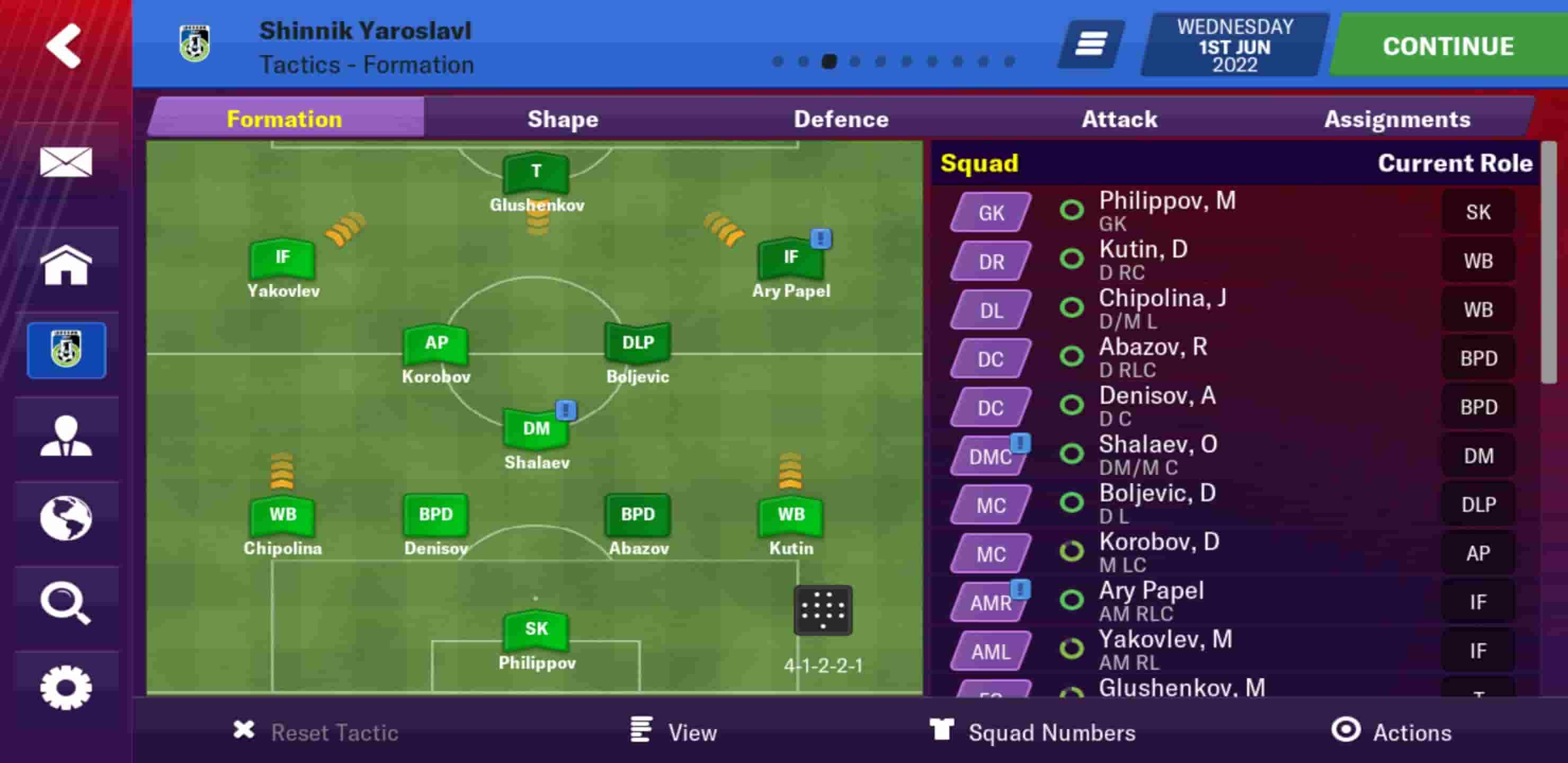
Where Football Manager really shines though is the overall feeling of progress and achievement, especially if you pick a team in the lower leagues. You really get a sense of how difficult it is to run and succeed with a football team, given all the massive amount of stuff you have to keep track of (as well as the budget you have).
When you do manage to make your goal though, such as being at the top of the table, or just avoiding relegation, it really makes you feel awesome. For the most part Football Manager 2019 is a good upgrade to the previous game, even though it still has a few things here and there that it can improve on (such as talking to the press).
The only thing I’d warn you about is that if you aren’t a fan of football, you might have a very hard time playing this game, as the tactics and minutia of running a football team can have running around like a headless chicken in no time. Even so, it’s a pretty fun game and one of the best management games out there, so if you’re willing to put in the effort, you won’t be disappointed.
#6 Motorsport Manager
Another game that’s very similar to Football Manager, instead of managing a football team, you manage a motorsports team, more specifically F1. There’s actually quite a bit of similarities between the games, but even though they’re published by the same company, the developers are different and the games themselves are also considerably different.
For example, whereas Football Manager’s UI looks like a spreadsheet, Motorsports Manager’s UI is a bit easy to navigate and understand. Speaking of the UI and navigation, a lot of the time spent on motorsport manager is here, and there’s quite a lot to go over.
The most important thing is undoubtedly setting up your cars and researching and improving parts, which has the biggest effect on the performance of each car. What’s cool is that when you research new parts, you can slot components in, up to 5 as your research level increases, and these give you small extra boosts to performance.
Aside from that, you also need to pick your sponsors, the main way you’ll be getting that sweet sweet dough. It’s not that simple though, because some sponsors have certain requirements, such as finishing in 9th or above. It’s actually a pretty cool little system that not only adds a little touch of authenticity, it also gives you some extra bonus money, especially if you can hit their targets.
Finally, there’s the HQ upgrades, something which is similar to Football Manager, and which can give you a bunch of different bonuses. For example, you have the design school you can upgrade, or the wind tunnel you can build, both of which help give your car better performance. On the other hand, there’s a telemetry center which gives you a ton of useful information for the actual race day.
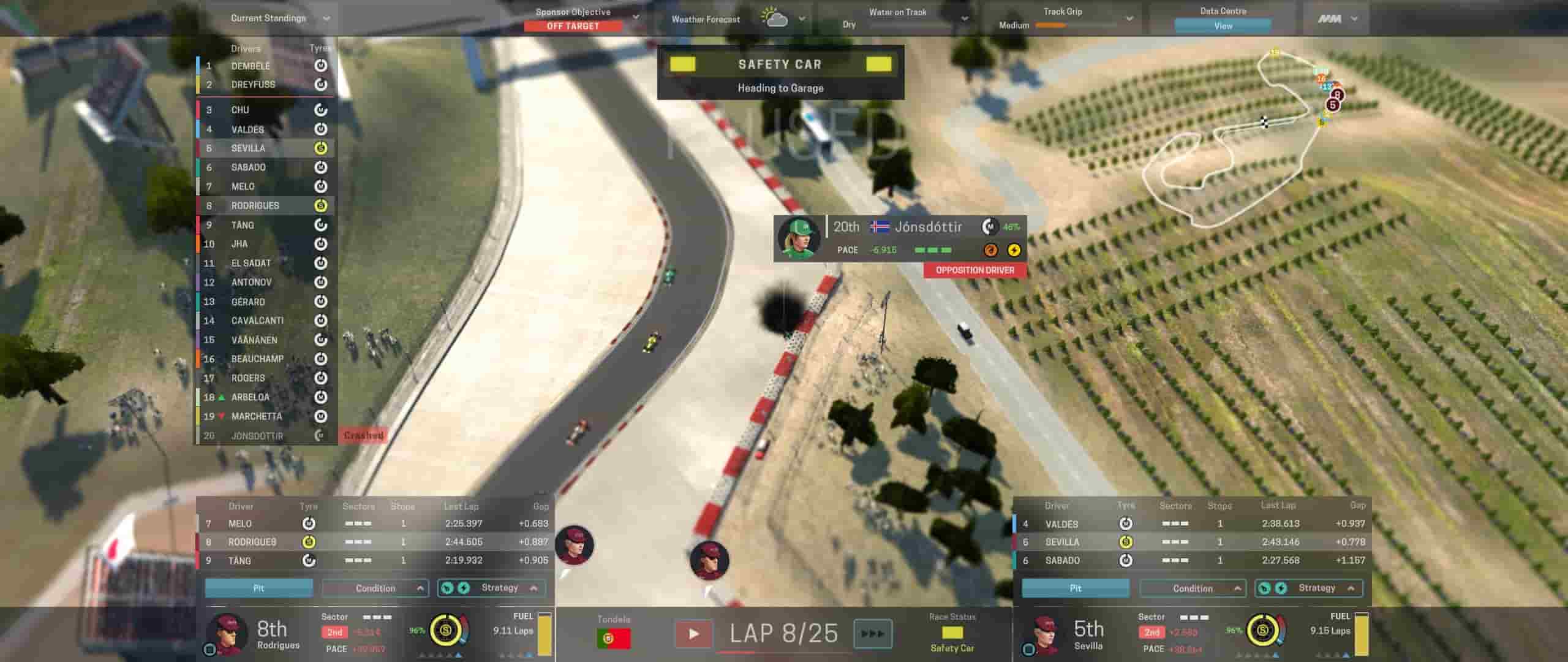
Speaking of race day, unlike Football Manager, Motorsport Manager puts a much larger emphasis on the live portion of the game.
First, you get to run a test race, which allows you to adjust things such as downforce, camber and gear ratios, all of which are targeted to the driver of each car (of which you get two). You also get to choose what kind of tires you want to go with, such as soft or even wet if it looks like it’s going to rain. This test race gives you a pretty good idea how to setup your vehicle and what strategy you want your drivers to follow.
Once they go into the race proper, you now begin to micro-manage their specific strategies, with different levels each for tyres and engine. Since tyre wear and fuel are both simulated here, you really have to be on top of your game to make sure that you aren’t taking an extra PIT stop when you don’t need one. It’s actually surprisingly challenging for what it is, so I’m pretty impressed.
For the most part, that’s the main core of the gameplay loop, and it’s actually tons of fun. You can choose from a variety of teams at different spots on the table, depending on what you’re aiming for. I’ve always enjoyed the rags to riches stories, so I always tend to pick teams lower in the leaderboard and slowly crawl my way up, but it’s equally as fun choosing a top team and trying to defend your position from a bunch of hungry upstarts.
#7 Stardew Valley
Games like Stardew Valley are becoming some of the most popular games out there and for a really awesome reason. Being as much a life simulator as a management game, there’s just so much stuff to do in this game that it’s almost mind-boggling.
The game starts off simply enough; you find yourself in a dead-end job for a super-massive corporation that doesn’t care about you. Tired of working for the Man, you decide to open up a letter given to you by your grandfather, who bequeathed you a farm. So, you promptly quit your job, pack your things and head out to your new farm.
On the surface level, the game may very well look like a farming simulator, but it’s actually surprisingly deep. While you do have a variety of crops to plant, harvest and sell for some much-needed moolah, you can also go out and do other stuff. For example, you’ll likely have to go around and harvest the trees and woods nearby for materials.
Not only that, but you do actually have a bit of a social presence in this world, in so far that you can actually start dating and even end up marrying somebody to live happily ever after with you. Sure, you woo them with flowers and small gifts, and it’s nothing incredibly exciting, but the level of simulation is great.
But really the big thing driving force her is rebuilding the community center, which not only confers some really great items, but also sometimes opens up new areas. One example is the destroyed bridge, which, once you rebuild it, gives you access to the quarry which has an absolute ton of resources. Which, of course, you can then use to help rebuild the community center.

If farming and socializing is not necessarily your thing, you could always take yourself and head over to the local endless dungeon for some combat. It’s nothing super fancy, very reminiscent of old-school Zelda games, but it’s a great source for some experience and resources. It also gets progressively more difficult as you get down, and while I say it’s endless, I’m not actually sure if it is or that nobody has managed to get that far.
Really though, one of the cooler things with Stardew Valley is that you can invite up to three people into your game for some co-op. They can help you farm, go into the dungeon and just generally hang out with you. Heck, you can even pretend to go off and do something important, but instead just go fishing, just like in real life . . . sort of.
Thankfully, the devs have put a ton of effort into this game, and it’s been receiving a lot of content that just keeps making it better. Overall, Stardew Valley represents not only one of the best management games out there, but one of the best management games with RPG elements, such as Farm Quest. You can easily sink 60-70hours into this game before you reach its end, so it’s well worth the purchase.
If you’re thinking about picking up the game, you might need some tips and tricks in the form of a Stardew Valley guide.
#8 Surviving Mars
Now, I’m actually a super big fan of space related stuff, and the idea of trying to survive on a hostile planet like Mars intrigues me to no end, and it’s no surprise that we consider it one of the best city-building games as well.
The biggest enemy you have when trying to survive on the red planet is resource scarcity, mostly in the form of water and oxygen, the two super-important building blocks of life. Thankfully, you aren’t forced to start off the game with human beings to worry about, but instead you’re provided with a set of really cute worker bee bots that can manage most things.
This allows you to slowly build up the basic infrastructure you’re going to need to be able to support life. It’s never that easy though, and the water extractors and oxygen generators will break down at some point, requiring maintenance using resources the worker bots can’t really procure.
This is where the humans step in, being able to run and work in the factories that help create the electronics and other things that are required to keep the machine well oiled. In fact, that’s a pretty common theme once you start building up and expanding your base.
Human beings are a bit finicky though, and require things like atmosphere and food, otherwise they die (what a terrible design). Habitats take the form of different sized domes that you can build, each with a certain amount of slots that you can construct different buildings. Housing, food production, research, even schools and grocery stores all go in there, making space a premium, as you’d expect.
What really shakes things up is the choices you go with when you start the game, as there are a variety of different sponsors for your mission, each with their associated funding, benefits and difficulties.

For example, if you go for the International Mars Mission, you get tons of funding and some great benefits for your game, which you can then use when you’re in a tight spot. On the other hand, if you go for something like India or Paradox Interactive (yes, they are actually a sponsor in-game), you don’t get much funding and things can get difficult.
It’s important to pick the right sponsor for your game, because they’re going to play in at some point, as you request things sent to you from earth to help. This can be food, materials or even resources used for maintenance, and it also includes the actual human beings that run everything. It only takes one major catastrophe to put a wrench in your well laid plans, so having that back is an absolute dream.
All of this is compounded by the mystery that can potentially rise up in your game, of which there are 12 in different levels of difficulty. They add a nice little touch to the world and help increase replayability. That being said, one thing that did bother me about the base game is that there was no terraforming mars.
Thankfully, Paradox Interactive came through with their Green Planet DLC, which added that and made the game infinitely better. So, if you’re going to pick up this game, then definitely pick up that DLC as well. Surviving Mars is an interesting game, where you’re not only managing a colony on another planet, but also the stresses and anxieties that go with being a few steps away from disaster.
#9 Moonlighter
If you’ve ever played Recettear, Moonlighter is a recreation as well as an upgrade on the shop management and dungeon fighting mechanic.
Much like Stardew Valley, you grow up working and inheriting an item shop, one that is somewhat successful but still middling. The thing is, you’re tired of the shop life; you want to go out, see the world have some adventure. With that ambition in mind, you kit yourself up and journey to the nearby dungeons.
There’s five dungeons in total that are procedurally generated, and each unlocking as you progress through the story. Combat is fun, although not necessarily groundbreaking, with the mobs inside offering interesting challenges as you try and figure out the best way to approach them. You also get quite a variety of weapons and armor that you can craft, equip and upgrade.
Where the real meat lies though is in the items that drop from mobs and that you’ll end up selling at your shop. There’s actually a pretty interesting inventory system, wherein certain items you pick up can have effects on other items.
Sometimes they can be positive, such as sending them directly back to your shop, and others are pretty negative, such as destroying adjacent items if you take too much damage. So there’s certainly a level of intriguing complexity when it comes to managing your inventory.
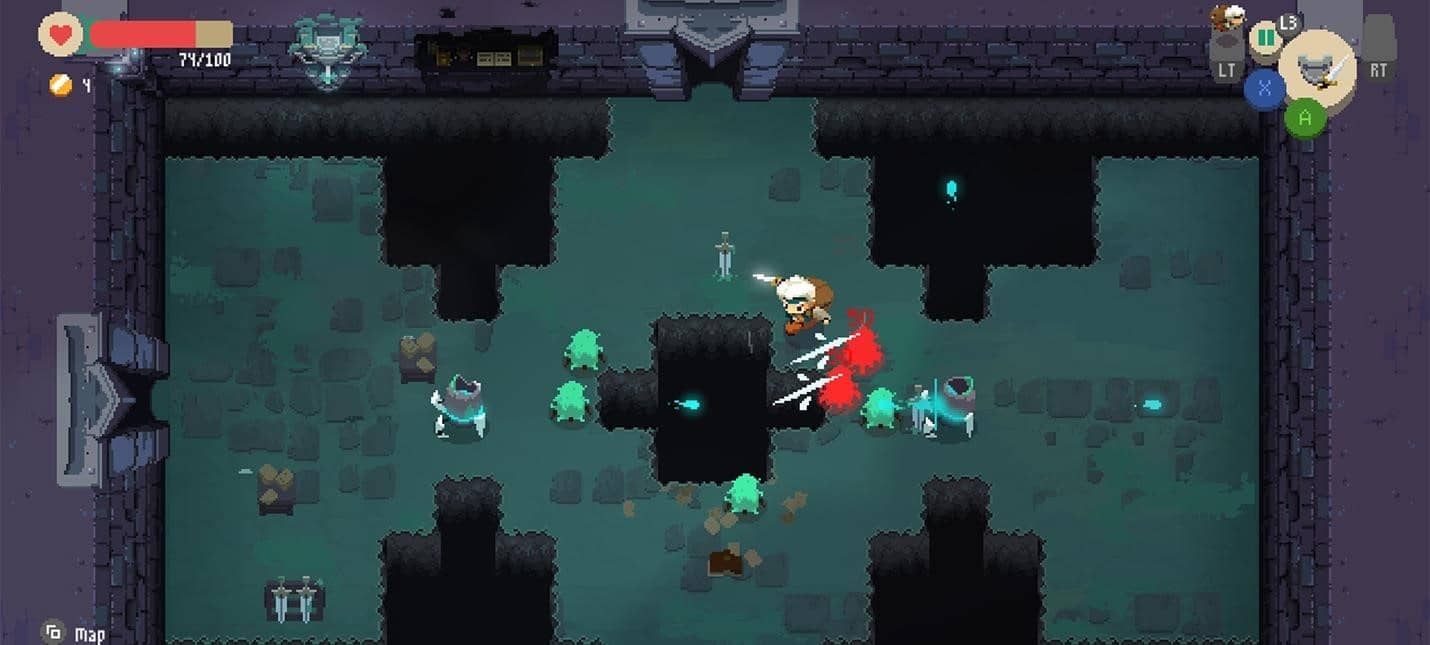
Of course, the other half of the game takes place in the town and your shop, where you can sell your wares in the day time. Unfortunately, you don’t really get to negotiate prices like you do in Recettear, but instead you get a sort of trial and error system where you price items and then customers will tell you whether they are too expensive, too cheap or just right.
You can also upgrade some things here and there in the shop that provide buffs, but it’s not that extensive. The town itself is also quite interesting, since you can actually build new things there, mostly in the form of other shops. These can offer some really great services, such as a potion shop, and you even get a competitor you can buy stuff from, although that will mostly be for crafting resources.
Speaking of, the blacksmith is where you’ll be spending a lot of your dosh, as he’s the one who makes and sells the majority of the good armor and weapons in the game. Moonlighter is an interesting game, in that it doesn’t necessarily innovate with every individual mechanic, but instead it’s more than the sum of its parts.
The dungeons can be both fun and frustrating, especially if you die and drop everything, but at the end of the day, there’s a lot of satisfaction to be had by selling your hard earned loot in your shop. Plus, how often do you get to be a shopkeeper by day and moonlight (yes, we saw the pun coming) as an adventurer at night.
#10 Dwarf Fortress
I was a bit hesitant to put this game on the list, mostly because it has quite a reputation for difficulty and simple graphics. Really though, when you look at the game beyond just the face value, you start to see one of the most complex simulation and management games out there. Not only that, but the game is completely free, so you don’t have to spend a dime to play it.
The game has two modes: Fortress and Adventure. Regardless of which you choose, before you start the game you have to generate the world procedurally. The thing is, it’s not just a procedurally generated map, but instead a procedurally generated history spanning up to hundreds of years, with its own myths, religions, colonies, empires, and everything that you can imagine. So as you can see, it’s a very, very deep simulation.
Fortress mode, the one that’s made the game famous and is the main mode, sets you out in creating and establishing your own dwarf colony. After choosing your starting location, you start off with only a few dwarves, around 6, and you have to set about trying to survive and build your empire. While this is pretty standard fare compared to other games of its nature, the UI is really complex, and sometimes you can find menus inside menus.
The UI, and the graphics themselves, is really where most people get put off from playing the game, but really, you don’t have to use the ASCII graphics of the game (and in-fact I’d suggest you get the starter pack).
Dwarf Fortress has a massive modding community, and some of the mods are tilesets you can use for the game, giving it some graphics (although mostly still in 2D). Even so, the UI is still a bit difficult to navigate, especially since there’s no one unified way to navigate; you might have to either use the arrow keys, +/-, or even the mouse.
Adventure mode might be a bit simpler if you don’t want to go through the hassle of building a colony and the insanely deep UI. Again, it’s actually pretty standard fare compared to most other games that have an adventuring aspect to them, and you can really approach it like an RPG.
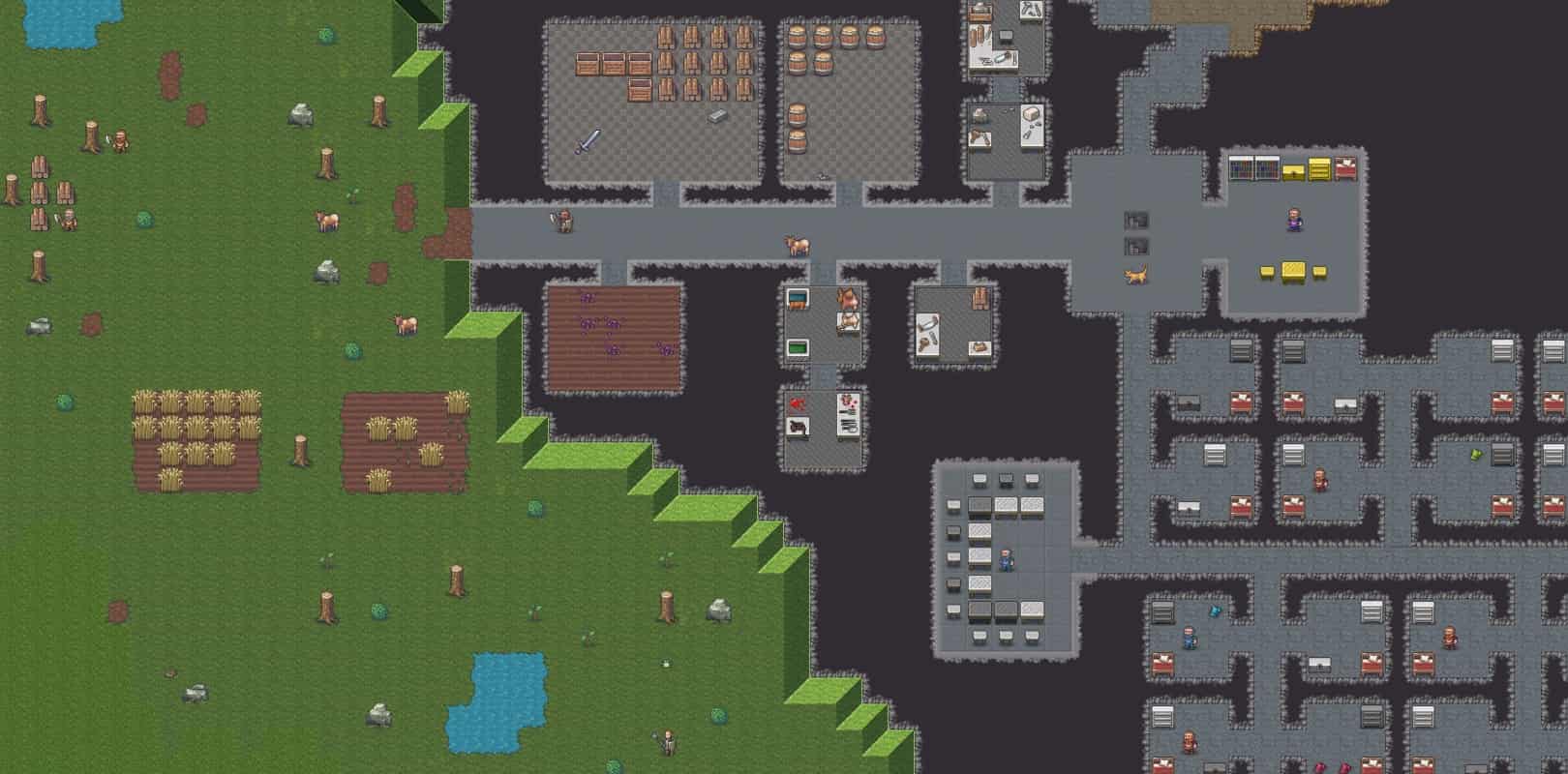
What the game does offer beyond pretty much anything else, is the purely massive amount of detail provided to you as things happen. Every fight, every move, every feeling, every action, every single thing that happens to the world is listed and provided to you. A fight between a dozen dwarves will spawn pages upon pages of texts describing the minutiae of what each dwarf did in that fight.
This is really where the game shines, because there’s no real challenges or win state. Dwarf Fortress is all about creating your own story and your own challenges. The Wiki helps a lot with this, not only for learning the game, but also for being inspired by challenges that other plays have created for themselves and trying to follow in their footsteps.
Overall, Dwarf Fortress is essentially a perfect simulation/management game, because it literally tells you everything. Where it lacks in is the ‘game’ part, since there’s not much to do except for what you want and your goals. So, if you can get past the steep learning curve, you have an insanely in-depth and detailed sandbox to do whatever you want, and the best part, is that it’s completely free.
Conclusion
As you can see, management games encompass a lot of stuff, and can take you from the fantastical world of dwarves, all the way to the harsh and barren surface of Mars. I’ve done my best to include a few different varieties of management games, in the hope you’ll find at least one that piques your interest. Whichever way you go though, I hope you enjoy your gaming and good luck not running everything into the ground!